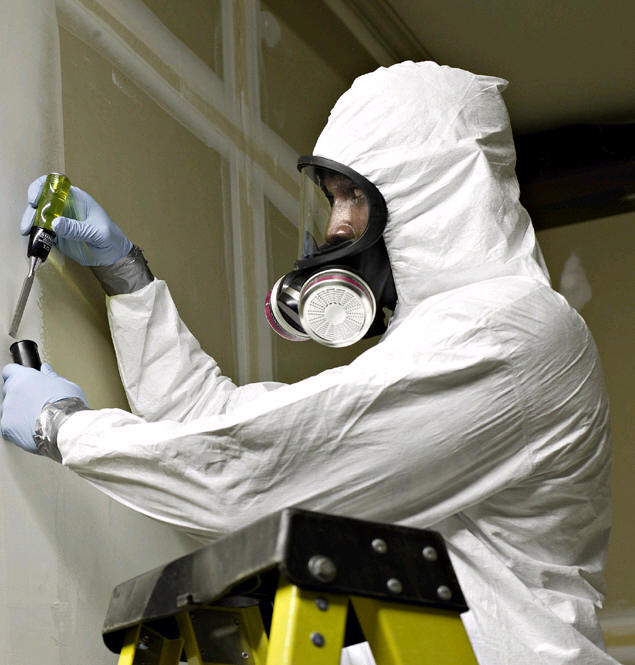Why Asbestos Testing is Necessary for Securing Your Health and wellness
Why Asbestos Testing is Necessary for Securing Your Health and wellness
Blog Article
The Full Process of Accredited Asbestos Evaluating to Guarantee Property Conformity
In the realm of residential or commercial property management and compliance, the process of recognized asbestos testing stands as an essential element to make sure the security and health of occupants. From the first evaluation to the final interpretation of results, each stage plays a crucial duty in identifying the visibility of asbestos within a property.
Accredited Asbestos Testing: First Analysis
In performing the preliminary evaluation for recognized asbestos screening, a precise evaluation of the home's products is vital to precisely determine prospective asbestos-containing materials. This crucial action entails aesthetically evaluating all locations of the home, including ceilings, walls, flooring, insulation, and other building materials that may harbor asbestos. Unique attention is offered to materials that are susceptible to harm or disturbance, as these scenarios can launch hazardous asbestos fibers right into the air. Additionally, tasting of thought materials might be required to validate the presence of asbestos with research laboratory analysis.
Accredited asbestos assessors follow stringent procedures established by governing bodies to guarantee the accuracy and integrity of the testing process. By diligently documenting findings and using advanced screening techniques, assessors can offer property proprietors with an extensive record describing the presence of asbestos, if any type of, and the recommended steps for mitigation or elimination. This first evaluation establishes the foundation for succeeding actions to deal with asbestos problems and make sure the safety and security and conformity of the residential or commercial property.
Example Collection Treatments for Asbestos Testing
Effective sample collection treatments are crucial in ensuring accurate asbestos screening results and conformity with regulative standards. When gathering examples for asbestos screening, it is essential to follow rigorous methods to lessen the threat of contamination and guarantee the dependability of the outcomes.
First of all, it is essential to recognize the suspected asbestos-containing products (ACMs) and prioritize sampling areas based upon aspects such as the material's problem, availability, and potential for disruption. Asbestos Testing. Samples ought to be collected from various areas within the property to supply a thorough analysis of asbestos presence
Throughout sample collection, certified specialists must use ideal personal safety equipment (PPE) to guard against asbestos exposure. They must make use of clean tools, such as disposable handwear covers and plastic bed linen, to stop cross-contamination between samples. Samples need to be meticulously gathered making use of a specified method, such as damp cleaning or coring, and safely sealed in closed containers to maintain their stability during transportation to the laboratory for evaluation.
Lab Evaluation Refine for Asbestos Examples
Upon conclusion of the example collection procedure, the asbestos examples are diligently moved to recognized laboratories for careful evaluation. The initial step in the lab evaluation procedure is sample preparation, where the accumulated samples are thoroughly refined to extract the asbestos fibers.

Once the analysis is complete, a comprehensive record is created, detailing the searchings for and validating whether asbestos is present, the kind of asbestos fibers identified, and the concentration levels. This information is vital for homeowner to take the essential steps to make sure conformity with asbestos guidelines and guard the health of occupants.

Coverage and Interpretation of Asbestos Examination Outcomes
Certified asbestos screening research laboratories provide detailed records that home use critical insights into the existence, type, and concentration degrees of asbestos fibers located in samples gathered from residential properties. These reports are crucial for residential property proprietors and managers to recognize the danger presented by asbestos and make educated choices concerning its management or removal. The records normally consist of info on the methods used for screening, the locations where samples were taken, the kind of asbestos recognized (such as chrysotile, amosite, or crocidolite), and the focus levels of asbestos fibers detected.
Translating these outcomes calls for knowledge to evaluate the prospective health and wellness threats linked with asbestos exposure, identify the proper strategy, and ensure governing conformity (Asbestos Testing). Depending on the findings, suggestions might vary from proceeded tracking and maintenance to encapsulation or full asbestos reduction. Residential or commercial property owners should carefully review these records and seek advice from asbestos experts to establish an extensive prepare for addressing any kind of asbestos concerns identified
Making Sure Building Compliance With Asbestos Regulations
To keep adherence with asbestos laws, home owners must vigilantly carry out actions to ensure compliance with applicable regulations and guidelines. This includes carrying out routine asbestos inspections by recognized experts to determine any presence of asbestos-containing materials within the building. Once asbestos is determined, homeowner should follow asbestos management intends that rundown proper containment, removal, or encapsulation procedures to stop direct exposure and spread of asbestos fibers. Compliance additionally entails keeping comprehensive documents of asbestos testing, upkeep, and removal tasks for evaluation functions.
Home proprietors need to give asbestos understanding training to employees and residents to decrease the threat of asbestos direct exposure and ensure proper handling of materials that may include see it here asbestos. Furthermore, it is critical to remain educated about any type of updates or adjustments in asbestos regulations to change monitoring practices appropriately. By proactively attending to asbestos compliance needs, homeowner can develop a risk-free setting for residents and mitigate possible lawful and health threats related to asbestos exposure.
Conclusion
To conclude, approved asbestos screening is a vital procedure for making sure residential property compliance with policies. The initial analysis, sample collection treatments, laboratory analysis, and analysis of results are all essential actions in this process. By adhering to these procedures, residential property owners can determine and attend to any type of asbestos hazards present, safeguarding the wellness and safety and security of occupants and keeping conformity with governing needs.
Report this page